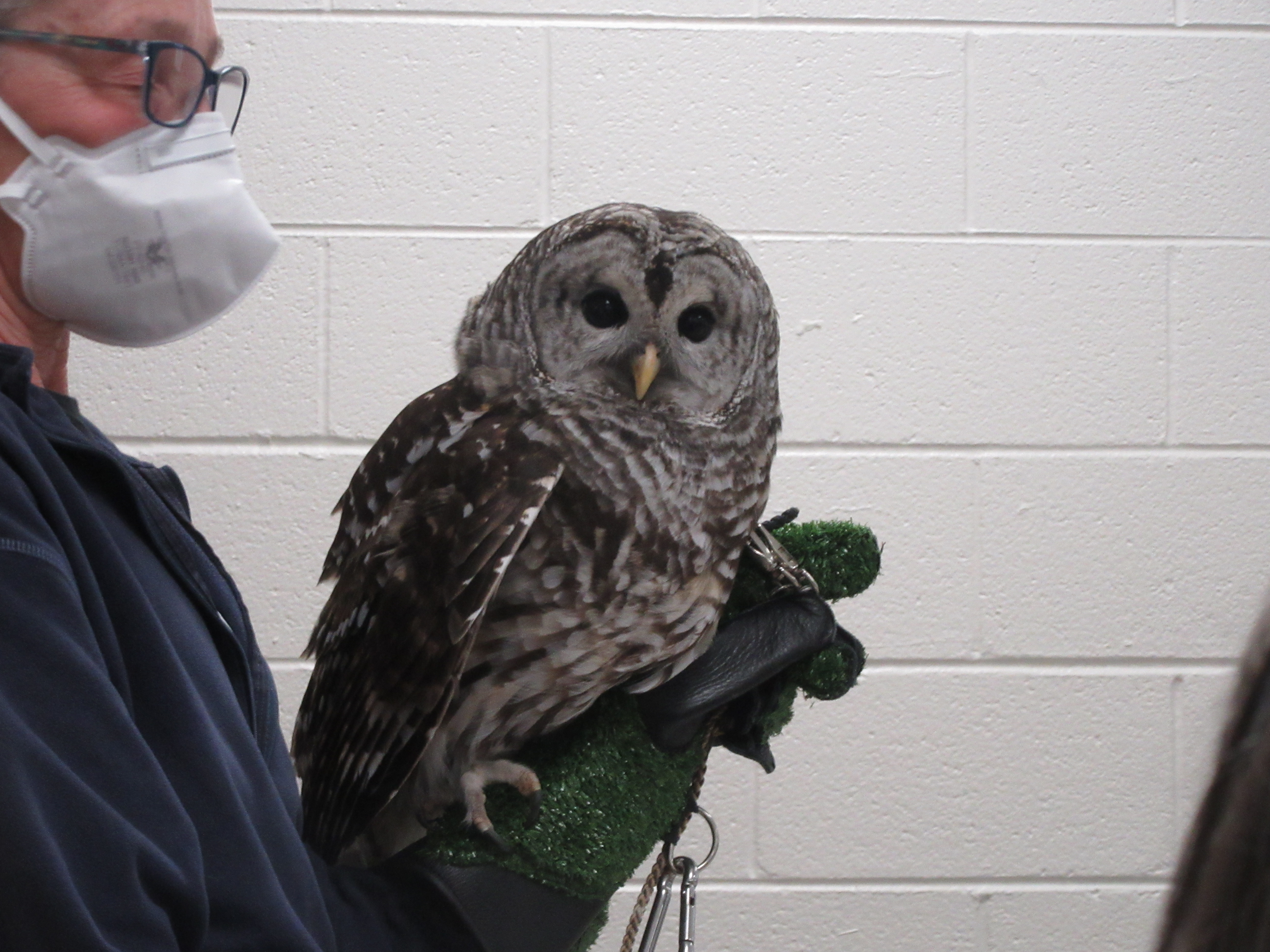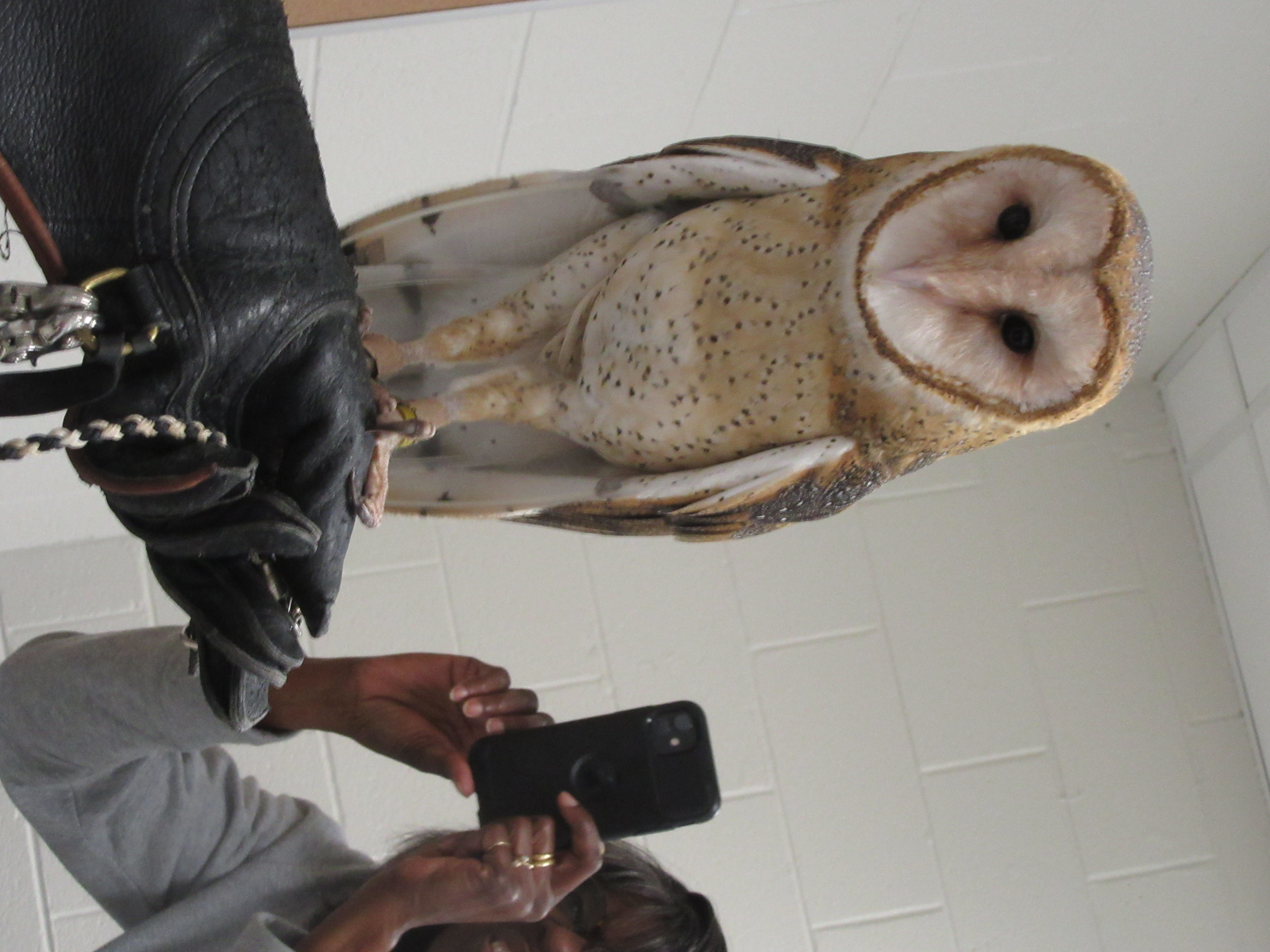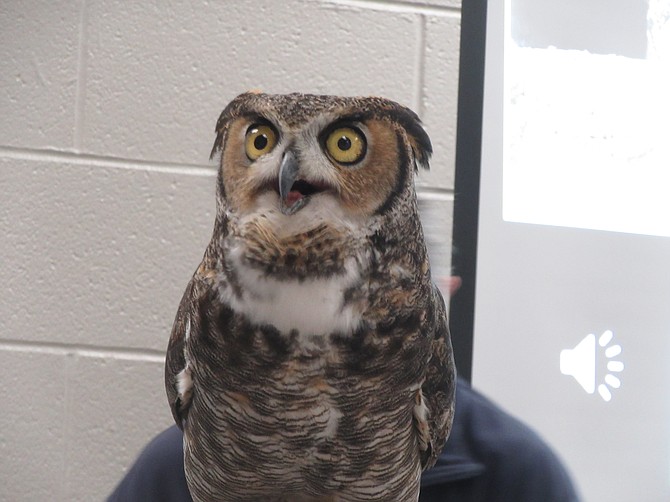A barred owl has 9,600 feathers. Barn owls have the best hearing of any animal. There are 250 documented owl species in the world, 19 in North America and eight in Northern Virginia.
These are some of the many intriguing owl facts that Liz Dennison reeled off on March 4 to 35 members of the Friends of Little Hunting Creek (FOLHC), including state Sen. Scott Surovell and Del. Paul Krizek. Dennison is president of the all-volunteer Secret Garden Birds and Bees. Assisted by her husband, Tim Dennison, and Nancy McDonald, she presented four different live owl species, three injured in the wild that cannot survive on their own and a fourth, a barn owl, raised in captivity. This was Friends of Little Hunting Creek’s annual meeting, held at the Gum Springs Community Center.
Dennison opened her power point presentation with “What Is an Owl?” and explained that four owl species nest in Virginia: barred, great horned, eastern screech and barn owls. Another four are seen occasionally: snowy owls, short-eared owls, long-eared owls and northern saw-whet owls.

Nancy McDonald showed the group a barred owl
Owls have excellent hearing. Their satellite-dish-shaped face funnels sounds to their asymmetrical ears. Unlike most birds which have eyes on the sides of their heads, owls’ eyes face forward. Owls have an upper and lower eyelid and a third one called a nictitating membrane. They can swivel their heads 270 degrees. Their beak curves downward.
Owls are usually hard to see, but a cacophony of calling crows can signal that an owl is nearby. Most owls are excellent at camouflaging and their feather colors blend in with tree bark. Many are primarily active at night.
Fringes on the leading and trailing edges of their wings enable them to fly silently. With sharp talons, they can catch and squeeze prey, like mice, shrews, voles, lizards and small birds. Dennison called them “ambush predators,” birds that sit motionless awaiting prey to come close before pouncing. Adult owls eat their prey whole and the parts that they cannot digest, like bones, they spit out as pellets.
The first avian guest “on stage” was Scarlet, a barred owl, a bird that likes forests and nearby water for bathing. Barred owls are around 21 inches long and a pound in weight. The name comes from their “bars” or striped plumage. “You will hear barred owls even if you don’t see them,” Dennison commented. She played a recording of their baritone call which some say sounds like “who cooks for you, who cooks for you-all.”
They are crepuscular, which means they are most active at dawn and dusk. That timing can put them at risk because these are common commuting times. Attracted to animals seeking food in discarded trash along the road, they can collide with vehicles.

Hodor, a great horned owl, sat patiently erect on Tim Dennison’s glove, staring with his intimidating eyes and sporting feathered head tufts, called plumicorns, which are not horns, Dennison explained. These owls are 22 inches long and weigh around three pounds.
They too are ambush predators and eat anything they can catch, including skunks and pet cats. Great horned owls do not build nests but commandeer other birds’ nests. They are found in forests, wetlands, grasslands, backyards, cities and other semi-open habitats. They mate for life and are raising their young now, Dennison said. She played their hooting call.
Eastern Screech Owl
Next up was Kvosir, a gray eastern screech owl with eyes injured in a vehicle collision. Compared to most owls, these are small, 8.5 inches in length and around six ounces in weight. Some are gray; some are reddish brown. They blend in well with the tree bark as they perch and nest in the holes and hollows of trunks. They camouflage so effectively, “If they close their eyes, they ‘disappear,’” said Dennison. They have several calls -- a trill, whinny and squeal.
Tim Dennison introduced Phantom, a barn owl with a heart-shaped face, a bird around 16 inches long and one pound in weight. Females are more speckled than males, Liz Dennison pointed out, and barn owls have the best hearing of any animal. Cornell University’s All about Birds, concurs. “The barn owl has excellent low-light vision and can easily find prey at night by sight. But its ability to locate prey by sound alone is the best of any animal that has ever been tested. It can catch mice in complete darkness in the lab or hidden by vegetation or snow out in the real world.”
Barn owls have probably inspired ghost stories, Dennison speculated, because they are whitish, active at night, glide silently and have a loud banshee-like scream. They like to live in barns, she said, because typically there are many rodents there, a staple of their diet.
Dennison lamented the spread of avian influenza, a contagious, lethal virus. She said that both waterfowl crowded close together and some poultry in close quarters can enhance the spread. A hot, dry summer could help kill the virus, she maintained.
On Saturday, the Friends group elected their Board of Directors and re-elected incumbent President Elizabeth Martin. Alyssa Hemler, with the Northern Virginia Conservation Trust, described her organization’s work on their property which borders Little Hunting Creek along Stockton Parkway, including planting trees, installing wood duck boxes and putting in two benches. FOLHC Board member Bryan Birch reported progress in creating access to the creek from the Martin Luther King Park, noting that the Fairfax County Park Authority has designated $600,000 to develop a plan.
How to Help Owls
Keep yards natural, plant native plants and create brush piles. Visit https://www.audubonva.org/audubon-at-home .
If safe, leave dead trees in place. Dead wood is part of nature’s cycle. Wildlife use them for nesting, roosting, foraging, perching and other purposes. Dead trees are habitat for over 1,000 wildlife species, says the National Wildlife Federation.
Avoid rodenticides, pesticides, herbicides and insecticides. Visit www.RaptorsAretheSolution.org and https://www.beyondpesticides.org/.
Keep cats indoors. Visit https://abcbirds.org/program/cats-indoors/.
Make windows bird safe. Visit https://abcbirds.org/blog20/make-windows-safe/.
Reduce night lighting. Visit https://abcbirds.org/news/new-lighting-collisions-recommendations/.
More Information
http://www.secretgardenbirdsandbees.com
http://friendsoflittlehuntingcreek.org
If you find a sick, injured or orphaned animal, contact the Virginia Department of Wildlife Resources, 855-571-9003, https://dwr.virginia.gov/wildlife, or the Wildlife Rescue League, 703-440-0800, www.WildlifeRescueLeague.com.
